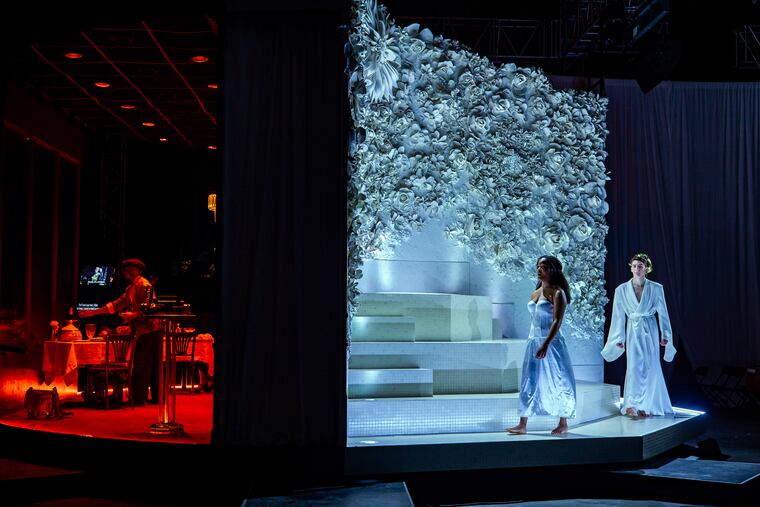Curtis Opera’s centuries-spanning double bill is as novel as it is confounding
A turntable stage sets brings together George Lewis’ newly composed 'The Comet' and Monteverdi’s 'Coronation of Poppea' from 1643

NEW YORK — Opera is such an open-ended art form, and Curtis Opera Theatre has long been inclined toward all manner of experiments that conventional companies can’t risk. In that enterprising spirit, The Comet/Poppea was presented in three well-sold performances Friday through Sunday in the unlikely venue of the 23rd Street Armory.
Conceived and directed by Yuval Sharon, this intriguing, cultivated but problematic juxtaposition of George Lewis’ newly composed The Comet and Monteverdi’s 1643 Coronation of Poppea revealed that the two operas had almost nothing to do with each other and were meant to thrive more on their purposeful random intersections than any planned coherence.
The Comet concerned two survivors of a modern apocalypse overcoming class and racial differences; Poppea is a 17th-century retelling of ancient Rome dictator Nero getting rid of previously loyal loved ones and claiming his new queen Poppea.
Seasoned opera-goers no doubt have hardly experienced anything like the production, seen here on its East Coast premiere following performances in Los Angeles and Santa Fe. This listener was 100% glad to be there for the theatricality of this 90-minute never-previously-attempted concoction — also offering a chance to access Sharon’s work.
Since his La bohème production was presented by Opera Philadelphia, Sharon has been tapped to stage the Metropolitan Opera’s next Wagner Ring Cycle. But in this double-vision production conception, neither opera made its full effect.
The armory space was dominated by a turntable stage, each half devoted to one opera. The two pieces took turns, almost like radio stations fading in and out. The Comet’s music was appropriately modernist: The disorientation of an unanticipated apocalypse was conveyed by atonal vocal lines and instrumental commentary that was full of diverse, disembodied extended effects — sounds rather than accompaniment, suggesting that all the usual rules of earthly existence had abruptly vanished.
Monteverdi’s language is concentrated in vocal lines intended to illuminate the words — traditional set-piece arias are few — with harpsichord-dominated accompaniment. The program notes discussed the possible mutual illumination of the two. Instead, I had to re-accustom myself to each world, which had radically different visual representations.
In Mimi Lien’s set design, the Poppea side resembled an all-white Roman bath allowing one to imagine different settings. The Comet side was a posh hotel the survivors happened into, decorated in bordello red and suggesting the gilded era of robber barons. With the audience seated on each end of the constantly moving turntable (and the orchestra off to the side), viewers got the same show but at slightly different times. Luckily the singers were amplified so one could hear them even when not visible — and to overcome the underlying grinding noise from the turntable.
Neither the production nor the overall conception worked in any conventional way — and probably wasn’t meant to. Having seen another of Sharon’s multiauthored productions — Proximity, which was focused on the theme of gun violence, at Lyric Opera of Chicago — The Comet/Poppea was admittedly influenced by see-what-happens theories of John Cage, tossing the question of meaning onto the lap of the individual listeners.
That meaning can change with every exposure to the piece — one reason why one patron I talked to after the Saturday show was dedicated to attending all three performances. Love or hate The Comet/Poppea, it wasn’t facile and was there to raise questions. Such as? Monteverdi’s Nero and Poppea get what they want (each other) with beautiful love music that bled into characters in The Comet lamenting over the death of their baby. Is the idea that love is what bridges the centuries? Even though the Monteverdi characters are incredibly corrupt and The Comet characters are anything but?
One problem: Was the audience given enough information to make such decisions? Operas such as Poppea speak to our century now that the early-music community has determined how they should sound. Here, isolated scenes were presented, devoid of their usual narrative. On The Comet side, the Douglas Kearney libretto preserved some of the language of the original 1920 W.E.B. Du Bois short story but had little sense of the scene-setting horror that gives the story urgency.
Sharon is perhaps saying that narrative need not be a primary element in opera (agreed), though the essence of any piece lacks meaning when robbed of context. I attended the Saturday performance having done much advance preparation. But is it fair to expect other listeners to do the same?
Also, the singers lacked the continuity to truly build their characterizations. Some were listed as “guest artists, original cast.” Among them, bass-baritone Cedric Berry as Jim in The Comet was excellent vocally and theatrically, though Curtis’ able soprano Kylie Kreucher, as his female costar, was by no means put in the shade. Curtis countertenor Sam Higgins made a double turn as Nero in Poppea and the robber-baron father appearing at the end of The Comet, singing well and looking much too boyish for either role but directing attention at what, in each theatrical setting, he was meant to be.
As Poppea, Curtis’ lush-voiced Puerto Rican soprano Jeysla Rosario Santos left you wanting to hear her much more. Also on the Poppea side, Evan Gray as the stoic Seneca and Amanda Lynn Bottoms as Ottone held the stage well. All Poppea singers were reasonably well-versed in Monteverdi style, right down to the vocal trills. Conductor Marc Lowenstein kept the musicians jumping convincingly between the two very different musical manners, though the brightly-voiced harpsichord in the Poppea sections made a chattering impression that wasn’t meant to be as humorous as it was. Or was it? No easy answers here.